|
|
|
Sort Order |
|
|
|
Items / Page
|
|
|
|
|
|
|
| Srl | Item |
| 1 |
ID:
075390
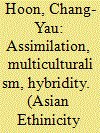

|
|
|
|
|
| Publication |
2006.
|
| Summary/Abstract |
The dominant discourse in accommodating the ethnic Chinese in Indonesia during Suharto's regime was one of assimilation, which forcefully aimed to absorb this minority into the national body. However, continuous official discrimination towards the Chinese placed them in a paradoxical position that made them an easy target of racial and class hostility. The May 1998 anti-Chinese riots proved the failure of the assmilationist policy. The process of democratization has given rise to a proliferation of identity politics in post-Suharto Indonesia. The policy of multiculturalism has been endorsed by Indonesia's current power holders as a preferred approach to rebuilding the nation, consistent with the national motto: 'Unity in Diversity'. This paper critically considers the politics of multiculturalism and its efficacy in managing cultural diversity and differences. It deploys the concept of hybridity to describe as well as analyze the complex identity politics of the ethnic Chinese in contemporary Indonesia.
|
|
|
|
|
|
|
|
|
|
|
|
|
|
|
|
| 2 |
ID:
127099
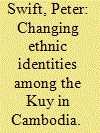

|
|
|
|
|
| Publication |
2013.
|
| Summary/Abstract |
The Kuy are one of the largest Indigenous groups in Cambodia. Though they are extremely similar to the Khmer in terms of physical appearance and material culture, a significant distinction between the two groups continues to be maintained. At the same time, assimilation into the Khmer identity has been a dominant trend among the Kuy for a considerable time and appears to be related to the relatively lower status of the Kuy identity. However, over the past decade or more, some people have begun to reassert a Kuy identity, driven by awareness of benefits of identifying as Kuy and a lessening of the stigmatisation of the Kuy identity. Following the introduction in Cambodia of the concept of Indigenous Peoples, 'Indigenous' has become an ethnic identity that more and more Kuy are assuming and within which they are becoming prominent. It is associated with a broader Indigenous community inside and outside of Cambodia which is becoming increasingly respected. The Indigenous identity has been able to inspire pride and confidence in a way that the Kuy identity has not and has played an important role in letting people of Kuy ancestry 'become Kuy'.
|
|
|
|
|
|
|
|
|
|
|
|
|
|
|
|
| 3 |
ID:
141162
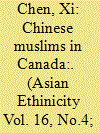

|
|
|
|
|
| Summary/Abstract |
To date, there has been little to no literature examining Chinese Muslim immigrants to Western nations. Recognizing the dearth of such literature, this research presents what appears to be the first-ever descriptive statistical picture of Chinese Muslims migrating to and residing in Canada. By examining how this immigrant population compares to and fares against non-Muslim Chinese and non-Chinese Muslims in Canada with Canadian census data in 1991 and 2001, the research provides preliminary analysis on the saliency of originating Chinese Muslim ethnicity in immigration outcomes. The current findings suggest that with the intersection of cultural and religious identities, Chinese Muslim may experience a different assimilation process compared to non-Muslim Chinese and non-Chinese Muslims.
|
|
|
|
|
|
|
|
|
|
|
|
|
|
|
|
| 4 |
ID:
093967
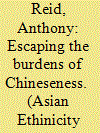

|
|
|
|
|
| Publication |
2009.
|
| Summary/Abstract |
Although Singapore currently makes it impossible in the male descent line, departing from Chineseness has been a common phenomenon in Southeast Asian history. In modern nationalist times the paucity of alternative terms in Southeast Asian and European language has made the overused Cina a problematic label, impossible to detach from a very large northern neighbour and from many cultural stereotypes. Naturally many local-born and culturally hybrid citizens have sought to escape from it. The best documented mass case is the nineteenth century Philippines. Peranakan Indonesians have not found it so easy to shed this inappropriate label even though it has occasionally been wielded as a death threat. 'Outsider' status also has its uses. This presentation will be chiefly concerned with the obstacles for Peranakan in departing from Chineseness. It will argue nevertheless that many Indonesians are quietly succeeding in taking this path.
|
|
|
|
|
|
|
|
|
|
|
|
|
|
|
|
| 5 |
ID:
134131
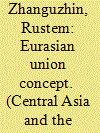

|
|
|
|
|
| Publication |
2014.
|
| Summary/Abstract |
The author probes deep into the concept of Eurasianism, the subject of heated discussions interpreted as an integration attempt in the post-Soviet expanse. He looks at the idea of Eurasianism as a civilizational project designed to unify all entities of the geostrategic expanse into a single whole. This multilayered problem cannot be exhaustively analyzed in one or even several dozen articles. Nevertheless, the subject deserves clarification as a target of analysis.
The political and economic vs. civilizational discourse looks very much like the chicken or the egg dilemma. The author prefers a civilizational discourse, although many will probably disagree with him.
|
|
|
|
|
|
|
|
|
|
|
|
|
|
|
|
| 6 |
ID:
073490
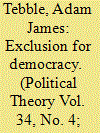

|
|
|
|
|
| Publication |
2006.
|
| Summary/Abstract |
Recent consideration of the politics of culture and identity has failed to capture an emergent trend in political practice that raises important philosophical questions for normative political theory. To rectify this, identity politics is examined in terms of two distinctions. Examining that politics in terms of the distinction between left and right, as well in terms of the distinction between normative discourse and the policies that discourse justifies, enables us to do more than account for three standard accounts of the politics of cultural turn: multiculturalism, conservative nationalism, and liberal nationalism. It also captures the newly emergent position of identity liberalism. This is a perspective that employs a progressive identity-based normative discourse typically considered to be the preserve of the multicultural left to defend a right-wing politics of assimilation.
|
|
|
|
|
|
|
|
|
|
|
|
|
|
|
|
| 7 |
ID:
138935
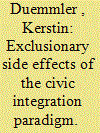

|
|
|
|
|
| Summary/Abstract |
Civic integration policies have become common in many European states and require that immigrants commit to integrating into the host society. This article draws on a study with young people in Swiss schools and investigates how these new political debates around civic integration find resonance in everyday narratives about immigration. The boundary approach is used as a framework to study the daily (re)production of the ‘Swiss–foreigner divide’. It reveals that assimilation into ‘Swiss culture’ (e.g. speak the local language and conform to social norms) remains a criterion defining who can become a legitimate member of Swiss society. Nonetheless, integration deficits are often perceived as the rule and transformed into a stigma so that ‘foreigners’ are frequently not recognised as legitimate members of society. This study indicates how the Swiss youth in this study legitimise and (re)produce exclusion and how this exclusion is embedded within past and current Swiss immigration policies.
|
|
|
|
|
|
|
|
|
|
|
|
|
|
|
|
| 8 |
ID:
193687


|
|
|
|
|
| Summary/Abstract |
Why do some Indigenous communities experience assimilation while others obtain government protection for their long-standing institutions and cultures? I argue that historical experiences with state-led labor conscription play a key role. In the early twentieth century, Latin American governments conscripted unpaid Indigenous labor to build infrastructure. Community leaders threatened by this conscription were more likely to mobilize their communities to resist it. The mobilization of this collective action later empowered community leaders to achieve state protections for Indigenous institutions and cultures, or “accommodation.” I test this argument using a natural experiment where communities’ eligibility for labor conscription to build a 1920s Peruvian highway was as-if randomly assigned. I develop a measure of accommodation that considers both the existence and enforcement of laws protecting Indigenous institutions and cultures. I evaluate the mechanisms using data on Indigenous mobilization. The findings demonstrate how historical extraction shaped contemporary Indigenous–state relations.
|
|
|
|
|
|
|
|
|
|
|
|
|
|
|
|
| 9 |
ID:
195181


|
|
|
|
|
| Summary/Abstract |
In recent decades, as part of the efforts of the Chinese government first to integrate and, more recently, to forcibly assimilate the Uyghur population into China’s mainstream culture and society, the Uyghur language has been marginalized and repressed to an unprecedented extent. The academic literature on Xinjiang’s language policy has repeatedly acknowledged that this repression is a major source of concern and discontent among many Uyghurs. However, to date, little has been written about the public response of Uyghurs to this policy and their open efforts to challenge it. In particular, with very few exceptions, little is known about the public response of Uyghur writers and artists. In this article I analyse a large corpus of Uyghur poems and songs that engaged openly with the Uyghur language crisis and were published and disseminated in the Uyghur public sphere between the mid-1990s and the mid-2010s. Unlike some studies that try to assess the condition of certain languages at a certain point in time through objective methodologies, these literary and artistic works provide an insider view on how the Uyghur cultural elite and many other Uyghurs experienced the repression and loss of their native language, and also, how they struggled against this repression. In the article I examine the diverse sentiments, perceptions, and discourses that these literary and artistic expressions communicate, and the different strategies that the Uyghurs used to struggle against the language policy and its consequences. I also explore what these works tell us about the development of Xinjiang’s language policy over time, the linguistic reality in the region, and the impact that the language policy has had on Uyghur society. Finally, the article also investigates the broad political meanings of these works and speculates on the link between them and the efforts of the Chinese government to further marginalize the Uyghur language.
|
|
|
|
|
|
|
|
|
|
|
|
|
|
|
|
| 10 |
ID:
134336
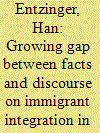

|
|
|
|
|
| Summary/Abstract |
The Netherlands’ recent history of dealing with immigrant integration provides an excellent example of the dangers of thinking in terms of fixed ‘national’ integration models. When first confronted with large-scale immigration, the Netherlands embarked on a policy of multiculturalism. Its current approach is one of the most assimilationist in Western Europe: several in-between forms have also been tried out. This article describes the evolution of Dutch thinking and Dutch policy-making on immigrant integration over the past few decades, and it analyses why the country has switched so frequently from one model to another. The harsher approach of this moment can be explained neither by major shifts that might have occurred in public opinion, nor by the actual course of the immigrant integration process, which has been advancing steadily. The root causes of the growing gap between facts and discourse lie in popular anxiety provoked by profound changes in Dutch society.
|
|
|
|
|
|
|
|
|
|
|
|
|
|
|
|
| 11 |
ID:
119496
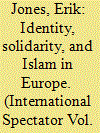

|
|
|
|
|
| Publication |
2013.
|
| Summary/Abstract |
Populists argue that Islamic immigrants are fundamentally different from Europeans. As evidence, they point to notions of religious and cultural identity. Such arguments have popular resonance. As more mainstream politicians pick up on these themes, they begin to take on an air of common sense. Nevertheless, they are mistaken. Europe has a long track record of reconciling competing identities. This has happened by focusing on patterns of interaction (solidarity) rather than obvious indicators of distinctiveness. Using the examples of the Netherlands and Turkey, this article illustrates the wide spectrum of European approaches to the challenge of getting different groups to share the same geographic space.
|
|
|
|
|
|
|
|
|
|
|
|
|
|
|
|
| 12 |
ID:
095381
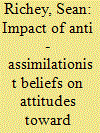

|
|
|
|
|
| Publication |
2010.
|
| Summary/Abstract |
I outline different beliefs about assimilation, and show that these beliefs can influence attitudes toward immigration. Using data from a new national sample survey in Japan, I test whether and how beliefs about assimilation influence attitudes toward immigration. The results show two important conclusions. First, there is a large anti-immigrant sentiment in Japan. Second, after controlling for other known determinants of attitudes toward immigration, I find that those who are in favor of immigrant assimilation support higher levels of immigration, more immigrant equal rights, and have more accurate views about immigrant crime in Japan. This suggests that those favoring assimilation are not necessarily xenophobic in all cultures.
|
|
|
|
|
|
|
|
|
|
|
|
|
|
|
|
| 13 |
ID:
134333
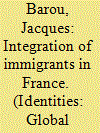

|
|
|
|
|
| Summary/Abstract |
This article seeks to identify the different factors that have facilitated or impeded the integration of immigrants in France from a historical perspective. Its aim is to shed light on the contemporary debates on the alleged failure of the republican integration model. First, we will show that – with the formation of the nation state – the integration of migrants was a constitutive element of the social cohesion of French society. Later, and during periods of xenophobia in particular, immigrants were classified according to their ability to assimilate into the French society. Since the 1970s, the double-barrelled integration question – concerning migrants and social cohesion – has reappeared. Within this context, the ‘colour-blind’ French republican model has been challenged, primarily from an economic perspective, not only by persistent social inequalities, but also, in its quintessence, by demands for cultural recognition. These factors have reinforced racial discrimination, the success of the populist extreme right and recurrent assimilation pressure.
|
|
|
|
|
|
|
|
|
|
|
|
|
|
|
|
| 14 |
ID:
171070
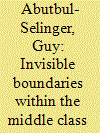

|
|
|
|
|
| Summary/Abstract |
This article explores the integration of ethnic minorities into the middle class in a novel way. Current literature examines the existence of boundaries and the ways they construct ethnic identifications through visible acts. One line of research perceives the middle class as a homogenizing platform that lowers residential segregation and labor market discrimination, while another demonstrates how stereotypes and an occupational glass ceiling continue to operate, reinforcing minorities’ ethnic identifications. By contrast, this article demonstrates the significance of invisible boundaries for the study of ethnicity in the middle class. I center on the ways whereby microaggression, namely tacit everyday insults, signifies an ethnic difference between middle-class adolescents. Analyzing adolescents’ narratives shows how the classification of spaces has given rise in minority adolescents to inner experiences of incongruence and subordination. By constructing an ethnic identity that prevents adolescents perceiving themselves as middle-class subjects, invisible boundaries reinforce the ethno-class order.
|
|
|
|
|
|
|
|
|
|
|
|
|
|
|
|
| 15 |
ID:
084558


|
|
|
| 16 |
ID:
185986
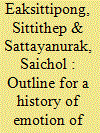

|
|
|
|
|
| Summary/Abstract |
This article attempts to cast the history of the Chinese in Thailand into a new light by framing it within the realm of emotion. Through writing the history of the Chinese from this new perspective and utilizing media such as newspapers, films, novels, etc., loaded with Chinese emotional expression towards the Thai state, society, and self as evidence reflecting emotional lives of the Chinese, we provide a preliminary outline to a history of emotions of the Chinese in Thailand. We argue that, in pursuing the assimilation of the Chinese into Thai society, the Thai state constructed an emotional regime based on the feeling of shame to govern the Chinese. The Chinese, however, found emotional refuge and liberation from the regime in transnational Chinese media and Thai-ified Sinophone literature, which played a significant role in identity politics of Chinese self-identification as neither Thai nor Chinese, but Chinese of Thailand.
|
|
|
|
|
|
|
|
|
|
|
|
|
|
|
|
| 17 |
ID:
101738
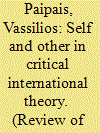

|
|
|
|
|
| Publication |
2011.
|
| Summary/Abstract |
This article is principally concerned with the way some sophisticated critical approaches in International Relations (IR) tend to compromise their critical edge in their engagement with the self/other problematique. Critical approaches that understand critique as total non-violence towards, or unreflective affirmation of, alterity risk falling back into precritical paths. That is, either a particularistic, assimilative universalism with pretensions of true universality or a radical incommensurability and the impossibility of communication with the other. This is what this article understands as the paradox of the politics of critique. Instead, what is more important than seeking a final overcoming or dismissal of the self/other opposition is to gain the insight that it is the perpetual striving to preserve the tension and ambivalence between self and other that rescues both critique's authority and function.
|
|
|
|
|
|
|
|
|
|
|
|
|
|
|
|
| 18 |
ID:
136071
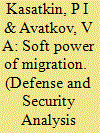

|
|
|
|
|
| Summary/Abstract |
The article studies the range of problems that have emerged due to the growing immigration from Muslim countries into the European Union (EU). While describing the functions of immigrants' communities, the authors focus on their political role in the receiving states. The study of the historical development of government–diaspora relations in three cases (the UK, France, and Germany) shows that Muslim communities' political influence does not reflect their economic and cultural role, which in the future might threaten the EU security, unless these countries develop a new approach to an “acculturation” policy.
|
|
|
|
|
|
|
|
|
|
|
|
|
|
|
|
| 19 |
ID:
169512
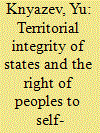

|
|
|
|
|
| Summary/Abstract |
BOTH PRINCIPLES mentioned in the title of this article were included in the UN Charter for good reason, despite their seeming contradiction. They concern not only the generally accepted conditions for settling international conflicts but also the very existence of multinational states, their internal homogeneity and interethnic contradictions that periodically arise.
|
|
|
|
|
|
|
|
|
|
|
|
|
|
|
|
| 20 |
ID:
143676
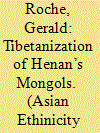

|
|
|
|
|
| Summary/Abstract |
The Sino-Tibetan frontier is typically portrayed as a large, complex, and diverse transitional region between Tibetan and Chinese cultural realms. The concept of Tibetanization is often deployed to classify the ethnically ambiguous ‘interstitial’ populations of this area. This article critically examines the concept of Tibetanization through a study of the Mongols of Henan County, Qinghai Province, a population repeatedly described as Tibetanized. A survey of local folkways reveals that Henan Mongols do, indeed, share many cultural practices with neighboring Tibetans. However, an examination of the historical processes underlying these similarities fails to identify anything that could be described as Tibetanization. Based on this finding, I problematize some of Tibetanization’s unexamined theoretical assumptions relating to concepts of ethnicity and assimilation. I conclude by asking what a critical reading of Tibetanization and the Sino-Tibetan frontier tells us about contemporary ethnopolitics in China and the academic practices that strive to represent them.
|
|
|
|
|
|
|
|
|
|
|
|
|
|
|
|
|
|
|
|
|